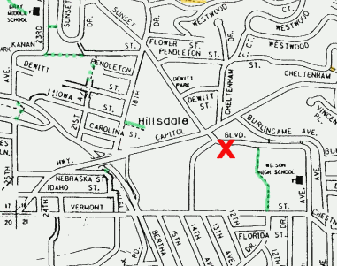 |

x marks the Hillsdale NET staging area behind the bleachers at Wilson High School Please be on time because we will carpool to the emergency. |
 |
 |

x marks the Hillsdale NET staging area behind the bleachers at Wilson High School Please be on time because we will carpool to the emergency. |
 |
|
for Southwest Portland NET's Saturday, September 11, 2004 starting at 9 am |
|
|
The Southwest Community Connection, Oct. 04 On a cool autumn day a sudden freak storm has hit a small area of Portland including a park where several parents and children are playing. High winds blow down trees and rip the corner of a roof off a garage. For 3 minutes, golf ball-sized hail pelts down, damaging plants, breaking windows and injuring people. Alerted by calls for help and children crying you arrive at the park where you see several people wandering about in a dazed state, or sitting or lying on the ground. The first person you encounter is a girl about 8 - 9 years old, on the ground near the teeter-totter, crying. Her arm is obviously broken. Between hiccuping sobs she tells you the wind blew her out of the swing and she crawled under the teeter-totter for protection from the hail. What should you do first? Second? Third? Farther on you can see a child the wind has deposited in the branches of a tree. A woman with a bloody head is huddled protectively over an infant. The infant is wailing, but the woman is not moving. A man is shaking a small, limp boy, calling "Peter! Peter! Wake up!" Two little girls are crouched, silent, by the fence. A 3-year-old is running around in circles shrieking, "Mommy! Mommy!" A woman from across the street runs up to you and says, "I've called 911. What shall I do now?" Downed trees are blocking vehicular access to the park so you know the usual 3-min. emergency response time won't be met. How do you answer the woman? The commotion in the park has attracted other people. A vigorous cane-wielding senior citizen reports, "Around the corner a tree brought down a power line. What can we do about it? My phone is dead." A young man arrives with a chain saw and without a word sets to work on the tree across the street. Two women carrying blankets and towels appear. "Can you use these?" they ask. From down the street someone shouts, "Where is Pat? Has anyone seen Pat?" What should you do? What can you do? There is no one right answer to the red italicized questions, but answers from a professional, and the reasoning behind them, will be given in the November issue of the Connection. |

Lt. Kevin Shanders and three responders
Photos:
Kevin Shanders
|
|
in The Southwest Community Connection, Nov 04 What should you do first? Second? Third? Most people would immediately rush to the aid of the child in distress, it's human nature. However, the Neighborhood Emergency Team volutneers have been trained to resist that urge. Instead, they stop and look for hazards first. They would look for downed power lines, precariously balanced broken tree branches, teetering chimneys, rising waters, etc. Next, they would try to get a handle on the entire incident, rather than blindly running from victim to victim. Without a search plan, a seriously wounded child could lie waiting for help for too long because they were busy treating someone else with minor cuts and scratches. The third thing the rescuer needs to do is assess the resources available. This could include first aid supplies, rescue gear, willing bystanders and neighbors, etc. Coordinating these into the rescue plan will make it much more likely that ALL the victims are taken of. "I've called 911. What shall I do now?" Since the woman lives nearby, she has a lot to offer. The ambulatory wounded could find refuge from the weather in her home. She probably has vital supplies at her house. Towels, blankets, water, bleach, lifting and cutting tools, flashlights, food and water could prove extremely valuable. |
Two
women carrying blankets and towels appear. "Can
you use these?"
Absolutely! Some of the injured people many not be movable. Blankets, towels and tarps couold protect them from the elements until trained rescuers arrive. "Where is Pat? Has anyone seen Pat?" What should you do? What can you do? NET
members learn to use the same search and rescue techniques used by professional
rescuers. They can identify safe places to search for missing people,
using search patterns to maximize their chances of success and reduce wasted
time and effort. Eventually, they might use these skills to look
for Pat. (After they establish whether Pat is a man, woman, child
or pet.)
|